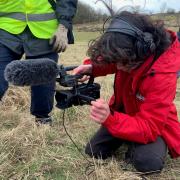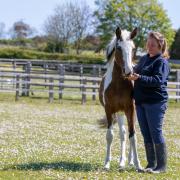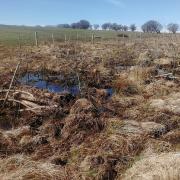Cast your mind back 390 million years. It isn’t easy is it?
This was the spell during Planet Earth’s history known as the Devonian Period, so named because the marine rocks that are considered symbolic of the period were discovered by geologists on the coast of Devon.It was a time of nescience as far as humanity was concerned – the first hominids were some 384 million years into the future – and the face of our planet was unimaginably different. It was a strange, primordial time. The arrangement of global land masses was very different: the north coast of Somerset was a semi-arid plain attached to what is today mainland Europe.What is now part of Somerset was relocated from the region of what we now call Germany and Belgium, moving along a mighty geological fault during the Carboniferous period (which came after the Devonian period); this time of great movement in the Earth’s crust resulted from the collision between Africa and Europe. And this was the time when life started to expand enthusiastically onto land; a time when plants, having moved out of an aqueous environment and into terrestrial habitats, began to diversify in order to develop the structures they needed to support their own weight out of water. In so doing, their root systems helped to stabilise the substrate on which they grew, giving rise to evolutionary changes in the landscape. And it is from this era that a recent discovery has been made that has brought coastal Exmoor to the attention of geologists worldwide: the oldest fossilised forest on Earth has been found on our doorstep. It pre-dates the previously known oldest forest, in the USA, by about four million years.

Caroline Cook, from the Exmoor National Park, tells me that the precise location is known to only a few academics, most likely to help protect the finds, but ‘it’s really exciting for us that Exmoor is the place where the world's oldest fossilised forest has been discovered. Whilst the sites are near to popular National Park walking routes, they are on the coastal cliffs below the rugged coast path and won’t be safely accessible to the general public.’ Discovered by Prof Neil Davies from Cambridge University’s Department of Earth Sciences, he tells me this was a chance find. ‘We were looking at the general environment in which the rocks were deposited, so this was a chance encounter,’ says Prof Davies. ‘Previously the rocks had been thought to contain only rare plant fossils, but we spotted the first trunks when sitting for lunch on the cliffs and then had our eye out for other examples, which we duly found.’ The fossils were identified by Dr Chris Berry, from Cardiff University’s School of Earth and Environmental Sciences. Ironically, he has been searching across the globe for a prototype forest like this for 30 years and when it finally turns up he realises that it was in his view all the time across the Bristol Channel in Somerset, not far from the visually striking ‘meringue’ of the Butlin’s holiday camp. ‘The fossils were discovered during fieldwork around 2020 by my colleagues from Cambridge University,’ says Dr Berry. ‘I saw a few hand specimens at that time, but I didn’t get into the field to see the in-situ plant fossils myself until early 2023.’ Dr Berry has spent decades studying similar fossils from around the world, which is how he was able to readily identify the Somerset finds. These fossils aren’t trees as we know them. Known as Calamophyton, this primitive type of tree resembles the Dicksonia antarctica, or Soft Tree Fern, a native to Australasia, which is often grown in the UK as an ornamental. These pioneering trees were short and grew densely together, with trunks comprised of woody supporting fibres around a hollow centre. Rather than leaves, their branches were covered in twiggy structures. Some of this vegetation was dropped onto the forest floor, supporting the embryonic cycle of life, including primeval invertebrates.

The discovery provides a glimpse at the development of vegetation on Earth. ‘There are two aspects to this discovery,’ explains Dr Berry. ‘Firstly, the trunks and branches of the first tree known in the fossil record, the Calamophyton, and secondly the bases of several trees showing their spacing when they were alive, allowing us to interpret the environment in which they grew. 'We already knew that this type of tree existed, as we’ve been able to study better fossils of the branches and, more rarely, the trunks, from localities in Belgium, Germany and USA. This type of tree belonged to an extinct type of plant called the cladoxylopsids, and they formed the first trees known. In these oldest cladoxylopsids, about 390 million years old, we think that they only reached a height of two to four metres, so they were very small trees. By five million years later cladoxylopsids had grown much taller and were joined by at least three other types of tree-like plants, and we have good examples of fossil forests from 385 million years ago, particularly in New York State and Svalbard.’

Dr Berry explains that a fossil forest is a site where the bases of fossil trees can be seen in their growth position, ‘so we are able to see their ecology, study the spacing and density of the trees, which tells us more about how much carbon they were storing, and study the environment in which they were growing by studying the sediment around them.’ Although similar fossils were already known from elsewhere, Dr Berry says that ‘these new discoveries are our first opportunity to study the oldest known trees in their growth position. They were growing on the banks of a small river channel which was part of an extensive branching river system which covered much of West Somerset and Devon at that time.’ The whole discovery, including fossilised logs and root systems, gives insight into how early trees shaped the landscape, stabilising riverbanks and coastlines. It was a time when there was little undergrowth, and grass had not yet arrived. ‘These ancient fossil forests are part of the data we need to understand the transition to a forested planet,’ continues Dr Berry. ‘During the Devonian period the Earth changed from a world where land plants were a similar size to mosses, to one where extensive forests of woody trees and diverse other plants were common. This had a dramatic effect on the Earth as a system, for example the hydrological cycle or the capture of carbon from the atmosphere. ‘At the same time, animal life developed on the land, including the evolution of fish into amphibians. Linking all these things together is the ultimate [research] goal.’

Rather unscientifically, I ask Dr Berry what that moment felt like, when it dawned on him and his colleagues what they were looking at. ‘The in-place tree bases are quite subtle and not easy to identify – my colleagues had to patiently talk me through what they found before we reached a sound conclusion, so there was no dramatic revelation,’ he tells me. ‘However, I was able to identify the trunks immediately when I saw the photographs – I have worked on this type of fossil for 30 years. They look a bit like tyre tracks across the rocks. I was really excited about this as I had not seen similar trunks from Britain before. I have worked on ancient forests and trees in many different territories: Belgium, Germany, USA, South America, Greenland, Svalbard, Russia, China amongst others….. But I didn’t imagine that the localities of the oldest fossil forests on Earth would be visible from where I am on the South Wales coast!’




























